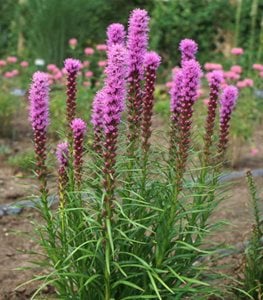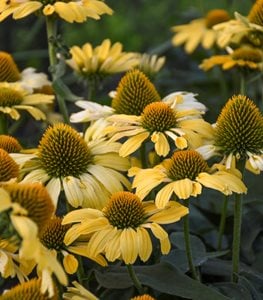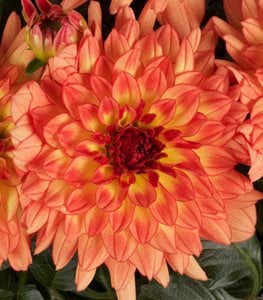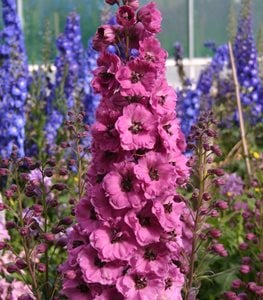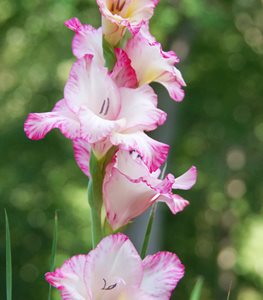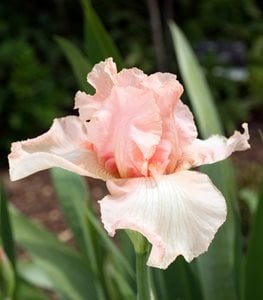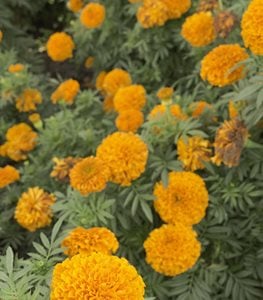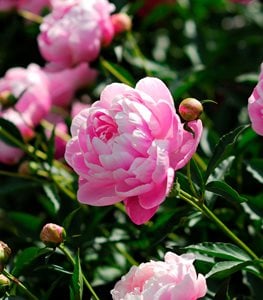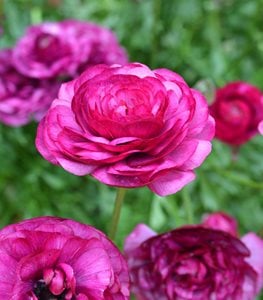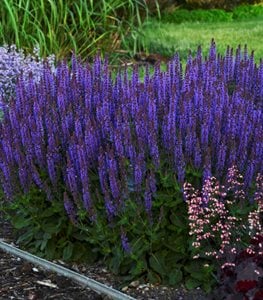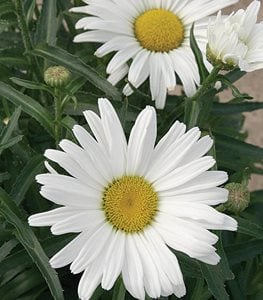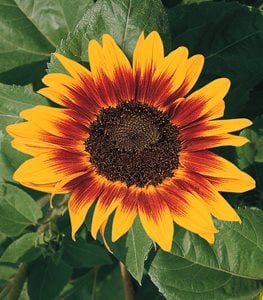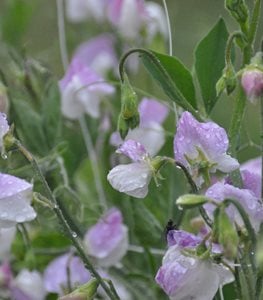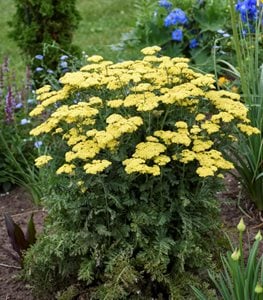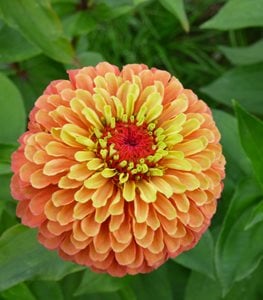24 FLOWERS FOR A CUTTING GARDEN
These vase-worthy flowering bulbs, annuals, and perennials will give you a bumper crop of blooms from spring all the way through fall.The saying “I’d rather have roses on my table than diamonds on my neck” sums up how many people feel about the simple pleasures of a vase of freshly cut flowers. Whether they are roses or another type of bloom, nothing brings more sparkle to a room than a bouquet of flowers harvested from your own backyard.
A cutting garden doesn’t have to be large to keep your vases full all season long. Even a small bed strategically planted with a variety of spring- and summer-blooming bulbs, brightly colored annuals, and a few long-blooming perennials and shrubs can yield a bountiful supply of homegrown bouquets.
Read more: How to Create a Cut Flower Garden.
On this page: Cut Garden Flowers | Tips for Keeping Cut Flowers Fresh
On this page:
CUT GARDEN FLOWERS A TO Z
ASTER (Symphotrichum and Aster)
Plant type: Perennial
Zones: 3-8
Bloom time: August through October
Height/Spread: 1 to 6 feet tall, 1 to 3 feet wide
These easy-to-grow, late-season bloomers are a wonderful choice for fall bouquets, especially taller varieties whose long stems are ideal for cutting. For the longest vase life, harvest asters once the flowers have fully opened. To encourage the growth of more blooms, pinch back the stems several times before mid-July.
Learn more about growing asters.
Pictured: 'Grape Crush' aster from Proven Winners.
BLACK-EYED SUSAN (Rudbeckia spp.)
Plant type: Perennial
Zones: 3-9
Bloom time: Midsummer until frost
Height: From 10 inches to 7 feet tall, depending on the cultivar
These prolific native wildflowers bloom in abundance from midsummer through autumn in cheery shades of yellow, orange, and gold. Like most wildflowers, they are also drought tolerant and low maintenance. For the longest vase life, cut when the petals have unfurled but before the tiny disk flowers have opened.
Learn more about growing black-eyed Susan.
BLAZING STAR (Liatris spicata)
Plant type: Perennial
Zones: 3-9
Bloom time: Mid to late summer
Height: 1 to 5 feet tall
Blazing star’s fuzzy florets of bright purple or white flowers bloom from the top down on unbranched stems, giving them a unique bottlebrush effect that provides vertical interest in fresh or dried flower arrangements. Because of its slender, upright form, blazing star also takes up minimal space, making it a good choice for smaller cutting gardens.
Learn more about growing blazing star.
Pictured: 'Kobold' blazing star from Proven Winners.
CELOSIA (Celosia spp.)
Plant type: Annual
Bloom time: Summer through fall
Height/Spread: 1 to 3 feet tall, 6 to 18 inches wide
A longtime favorite for cutting, these heat-loving flowers come in a variety of eye-catching forms ranging from feathery plumes to crested cockscombs, in vibrant shades of red, orange, yellow, and pink. Freshly cut flowers will last as long as two weeks in a vase or can be dried for other ornamental uses.
CONEFLOWER (Echinacea spp.)
Plant type: Perennial
Zones: 3-9
Bloom time: Summer to early fall
Height: 1 to 4 feet tall, up to 2 feet wide
With their long stems and large daisy-like blooms, coneflowers are ideal for adding height and bright color to a mixed bouquet. Even the spiky orange centers, with the petals removed, can be used as interesting accents in floral arrangements. By planting early- and late-blooming varieties, you can harvest flowers for cutting for up to five months.
Learn more about growing coneflower.
Pictured: Color Coded™ ‘Yellow My Darling’ coneflower from Proven Winners.
COSMOS (Cosmos bipinnatus)
Plant type: Annual
Bloom time: Midsummer until frost
Height/Spread: 1 to 6 feet tall, 1 to 2 feet wide
The cheerful daisy-like flowers of this cottage garden favorite bloom prolifically all summer long, with one plant producing dozens of flowers. In fact, the more you pick of this cut-and-come-again flower, the more it blooms, giving you an ample supply for all your summer bouquets. Both single- and double-flowered types are available, in shades of crimson, rose, pink, lavender, and white.
Learn more about growing cosmos.
DAFFODIL (Narcissus spp.)
Plant type: Bulb
Zones: Typically 4-8, but may vary
Bloom time: Early to late spring
Height: 6 to 30 inches, depending on variety
One of the first flowers to bloom in spring, with thousands of varieties to choose from. Although long-stemmed varieties are perfect for traditional floral arrangements, a few vases of miniature daffodils can make a charming spring display. For the longest vase life, take your cuttings before the flowers have fully opened.
Learn more about growing daffodil flowers.
DAHLIA (Dahlia spp. and hybrids)
Plant type: Tuber
Zones: 7-10
Bloom time: Midsummer until frost
Height/spread: 1 to 6 feet tall, 1 to 3 feet wide
These tried-and-true garden performers come in a dizzying array of colors and sizes, and just a few plants will give you armloads of blooms. Since dahlias don't open much after they’ve been harvested, wait to pick the flowers when they are at their prime. For the best flower production, pinch or cut back your plants early on—when they are about 8 to 12 inches tall—to encourage the growth of multiple stems.
Learn more about growing dahlias.
Pictured: Dalina® Grande Tequila from Proven Winners.
DELPHINIUM (Delphinium hybrids)
Plant type: Perennial
Zones: 3-7
Bloom time: Early to midsummer
Height/spread: 2 to 6 feet tall, 1 to 2 feet wide
The glorious spikes of delphinium bring stature and elegance to flower arrangements because of their striking colors and upright form. To get a second bloom from your plants in late summer or early fall, cut the stalks back immediately after flowering.
Learn more about growing delphinuim.
Pictured: New Millennium™ Pink Punch from Proven Winners.
FLOSS FLOWER (Ageratum)
Plant type: Annual
Bloom time: Late spring until frost
Height/spread: 4 to 36 inches tall, 6 to 18 inches wide
Fluffy pompom-like blooms in soft shades of blue, purple, or pink make outstanding cut flowers because of their unique form and wonderful fragrance. Newer varieties with longer stems are perfect for picking, giving you blooms that will last more than a week in a vase.
Learn more about growing floss flower.
Pictured: Artist® Blue from Proven Winners.
GLADIOLUS (Gladiolus x hortulanus)
Plant type: Corm
Zones: 8-10
Bloom time: Early summer to frost
Height: 2 to 5 feet
Nothing is more dramatic in a summer bouquet than the bold spikes of freshly cut garden glads. This cutting garden favorite is not only easy to grow, it also takes up very little space when planted in long rows. And because the corms are inexpensive, you can grow them as annuals and plant different colors and varieties each year. The best time to cut glads is when one or two of the lower buds have opened fully. The remaining buds will open when the spike is placed in water.
Learn more about growing gladiolus.
IRIS (Iris germanica)
Plant type: Rhizome
Bloom time:Spring to summer
Height/spread: 1 to 4 feet tall, 1 to 2 feet wide
The exotic blooms of the iris come in nearly every color of the rainbow, and by planting varieties with different bloom times, you extend the harvest for many weeks. For the longest vase life, cut the flowers when the first bloom on each stalk begins to unfurl. Because the buds on each stem open in succession, the younger buds will open as older flowers fade.
Learn more about growing iris.
MARIGOLD (Tagetes spp.)
Plant type: Annual
Bloom time:Late spring until frost
Height/spread: 6 inches to 4 feet tall, 6 inches to 2 feet wide
Marigolds and other flowers in shades of orange and yellow are especially striking when mixed with blue or purple flowers in summer and fall bouquets, such as salvia and blazing star. To save garden space, you can also interplant marigolds in your vegetable patch to help repel unwanted pests.
Learn more about growing marigolds.
ORNAMENTAL ONION (Allium spp.)
Plant type: Bulb
Zones: 3-8
Bloom time: Early summer
Height/spread: 1 to 3 feet tall, 3 to 18 inches wide
With their stiff, leafless stems and spherical lollipop-like blooms, alliums of all types are dramatic-looking cut flowers and are often used to add wow-factor to mixed bouquets. Because they belong to the onion family, alliums may give off a pungent aroma, especially when first cut. To minimize the smell, change the vase water frequently and avoid crushing or damaging the stems.
Learn more about growing ornamental onion plants.
Pictured: Millennium ornamental onion from Proven Winners.
PEONY (Paeonia spp.)
Plant type: Perennial
Zones: 2-8
Bloom time: May to June
Height/spread: 1 to 3 feet tall and wide
Peonies are one of the most popular cut flowers because of their large, billowy blooms and remarkable range of colors and forms. For the best vase life, harvest the flowers when the buds are somewhat closed but soft, like a marshmallow. You can even store your cut blooms in the refrigerator for display later if you have an over-abundance (see these peony storage tips from Michigan State University Extension).
Learn more about growing peonies.
RANUNCULUS (Ranunculus asiaticus)
Plant type: Tuber
Zones: 8-11, can be grown as an annual in cooler climates
Bloom time: Early spring to summer
Height: Up to 2 feet
These show-stopping spring bloomers (also called Persian buttercups) have long been a favorite of commercial florists because of their brilliantly colored rose-like flowers and long vase life. Because of their early bloom time, they are a great alternative to roses or peonies in spring bouquets.
Learn more about growing ranunculus.
ROSE (Rosa spp.)
Plant type: Shrub
Zones: Typically 4-11, but can vary
Bloom time: Spring through summer
Height/spread: 1 to 12 feet tall, 1 to 15 feet wide
With their showy blooms and intoxicating scent, roses are even more heavenly indoors in a vase than they are in the garden. Varieties with long stems and large fragrant blooms, such as hybrid tea roses, often make the best cut flowers, but even miniature roses look charming when tucked into small bouquets.
Learn more about the best types of roses for your garden.
Pictured: Oso Easy Double Red™ rose from Proven Winners.
SALVIA (Salvia spp.)
Plant type: Perennial
Zones: 5-9
Bloom time: Late spring until frost
Height/spread: 1 to 6 feet tall and wide
Salvia (ornamental sage) is a must in the cutting garden because of its long bloom time, aromatic foliage, and spiky purple flowers. As a bonus, you can also dry the leaves to add to potpourri.
Learn more about growing salvia plants.
Pictured: Color Spires® 'Violet Riot' from Proven Winners.
SHASTA DAISY (Leucanthemum superbum)
Plant type: Perennial
Zones: 5-9
Bloom time: Early summer to fall
Height/spread: 6 to 48 inches tall, 10 to 24 inches wide
All types of Shasta daisies are excellent additions to summer bouquets because of their strong stems and bright, cheery blooms. In addition to the classic single-petaled form, you can also find double, quilled, and fringed types, some even sporting yellow petals.
Learn more about growing Shasta daisies.
Pictured: Amazing Daisies® Daisy May® from Proven Winners.
SUNFLOWER (Helianthus spp.)
Plant type: Annual or perennial
Zones: 4-8 for perennial varieties
Bloom time: Summer through fall
Height/spread: Up to 16 feet tall
Sunflowers are often the superstars of late summer and fall flower arrangements. In addition to the classic bright yellow blooms, you’ll also find varieties with deep red petals, fuzzy double yellow flowers, and white petals with chocolaty brown centers. Varieties with large flower heads look great gathered together in large bunches, while those with smaller blooms work nicely in mixed bouquets.
Learn more about growing sunflowers.
SWEET PEA (Lathyrus odorata)
Plant type: Annual
Bloom time: Early spring to early summer
Height: Climbs to 6 feet when trained on stakes or a trellis
Dainty ruffled flowers in a wide range of colors have an irresistible scent of honey and orange blossoms. In Zone 7 and above, sow seeds in late fall for early spring blooms. In colder climates, sow in early spring. To get the longest season of production from your sweet pea plants, do not let the flowers go to seed. Cut them regularly to keep the blooms coming.
Learn more about growing sweeet pea flowers.
TULIP (Tulipa spp.)
Plant type: Bulb
Bloom time: Early to late spring
Height: 6 to 24 inches tall
With their tall, elegant stems and velvety petals, tulips are the quintessential flower in spring bouquets. For the most riveting displays, grow multicolored forms, such as the breathtaking parrot tulip, or blend varieties that bloom in complementary colors. When kept out of direct sunlight, heat, and drafts, a bunch of freshly cut tulips will last at least a week in a vase.
Learn more about growing tulips.
YARROW (Achillea spp.)
Plant type: Perennial
Zones: 3-9
Bloom time: Early summer to early fall
Height/spread: 1 to 4 feet tall, 1 to 3 feet wide
The broad, flat-topped flowers clusters of yarrow are particularly well-suited for layering or stacking in floral arrangements or to add a horizontal component to offset vertical design elements. They have a great vase life, too, lasting well over a week when harvested at their peak. Also save a few clippings for use in dried floral arrangements by hanging them in bundles upside down in a cool, dry place.
Learn more about growing yarrow plants.
Pictured: 'Firefly Sunshine' from Proven Winners.
ZINNIA (Zinnia spp.)
Plant type: Annual
Bloom time: Late spring until frost
Height/spread: 1 to 4 feet tall, 1 to 2 feet wide
One of the best cut-and-come-again flowers, offering great variety in color and form. Once they get established and start growing, these amazing plants will keep on producing nonstop if you harvest the blooms regularly. Be sure to cut the stems just above the leaf nodes because this is where new growth and flowers will form.
Learn more about growing zinnias.
For more: See this Cut Flower Guide for Shrubs from Proven Winners.
TIPS FOR KEEPING CUT FLOWERS FRESH
Harvest during the coolest part of the day. The best time to cut your flowers is early in the morning or late in the evening rather than during the heat of midday, when water loss due to transpiration is much greater. This will help them recover faster because they won’t be wilted, parched, and thirsty.
Don't let the stems dry out. Cut flowers rely on healthy stems to bring them water, so it’s important to keep them fresh. Carry a bucket of cool, clean water with you to the cutting garden at harvest time to plunge the stems into so they don’t dry out before you place your flowers in a vase. Clipping the stems at an angle with a sharp pruner and recutting them underwater will also facilitate water uptake.
Strip away lower foliage. Remove any leaves at the base of the stem that might rest below the waterline of the vase. Any foliage sitting in the water will rot and lead to bacterial growth, which will significantly decrease the life of your freshly cut flowers.
Use clean containers. Another way to minimize bacteria in the water is to sanitize your vase or container before filling it. Don’t use anything that isn’t clean enough to drink from.
Change the water often. Refreshing the water in your vase every few days is the best way to keep your cut flowers vibrant longer. This is also a good opportunity to remove withering foliage and flowers and to recut the stems so they will continue to take up water. Another tip: Your cut flowers will absorb water more efficiently if it’s lukewarm (about 100° F) rather than ice cold. That’s because the molecules in warm water move faster and speed water uptake.
Use a floral preservative. Those packets of powdered preservative you get from the florist, which are typically a blend of sugars and bacteria inhibitors, can be quite effective at lengthening the life of your bouquets. But you can also make your own preservative using common household products. Try this homemade preservative recipe from the Brooklyn Botanic Garden.
Place your cut flowers in a cool spot. To extend the life of your blooms, keep your floral arrangements in a cool location away from direct sunlight, especially during the summertime. Also consider refrigerating your cut flowers overnight, as many florists do, to slow down water loss and keep the flowers looking crisp and fresh.
RELATED:
Backyard Landscaping


